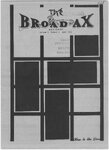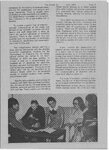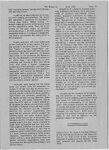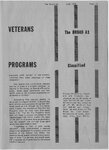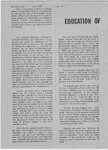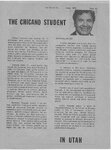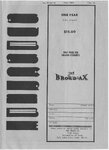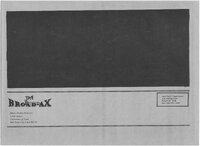| OCR Text |
Show The Broad Ax. June 1975 | Page 11 OWERVIGW. Statement by Dot Routh Educational Program Consultant Leadership Development Program Before the Subcommittee on Postsecondary Education for “It is my opinion Congress to look that the time is ripe seriously at Special Programs and their extreme significance, and to carefully consider the total picture of need, resources and service”’. So stated Dot Routh, Educational Program Consultant for the Leadership Development Program before the House Subcommittee on Postsecondary Education conducted last April. -Reporting on the United States Office of Education Task Force Report on the Disadvantaged and Postsecondary Education, Routh presented an overview of the Task Force findings and recommendations. Speaking of Special Service programming, Routh said, ‘At best there seems to be general confusion regarding these programs, and | strongly urge the committee to seek means of clarifying their legislative intent and of providing the most comprehensive and effective service possible, for the need, here,is urgent. Routh advised the committee that each of the Special Programs were introduced into Jaw at different times, and by different | agencies. Both Search (designed Upward Bound and Talent. to help students from Special Services came into being when it was discovered that students already enrolled in postsecondary education needed additional support services. were based Educational on-state Opportunity models adding Reporting on need and inequities, Routh related Task Force findings based on available research. The report concluded that only one out of every two youngsters from low income b kipdakidnivadi ate from high school, and of the most talented group, only one of every two ever attend college. Based on the upper quartile of high school graduates, studies found that only one in five graduate from college. Minority education statistics are also dim related Routh. In 1970 minorities constituted 16.8 percent of the U.S. population, but only 10.6 percent of postsecondary undergraduate enrollment. Furthermore, of minorities enrolled in postsecondary institutions, only one-fourth are enrolled in the upper division. Task Force findings for the physically handicapped showed that the country is educating only 40 percent of its handicapped population, while 60 percent receive a substandard education. Said Routh of the figures, ‘Certainly, equal education opportunity cannot exist as long as there are identifiable groups effectively excluded from participation in postsecondary education based on the accident of one’s birth, social status or physical characteristics. ’’ low income backgrounds in enrolling in postsecondary education), began in separate agencies. And, changes in eligibility of sponsoring institutions and agencies, adjustments of dollar amounts here and there, and the addition of new populations as they were recognized—| might add, without corresponding additional appropriations.” Centers little thought on relating to other programs. Said Routh, ‘Most amendments to these programs throughout the past decades have related to In talking to more than one thousand individuals connected with Special Service programs, the Task Force identified five major themes of general concern, reported Routh, The Task Force listed funding as the first of these concerns, citing ‘“‘numerous barriers to effective project planning and. Hallo tion.” ue One of these barriers, stated to the nature of competitive Routh, funding hich annually creates a lack of institutional commitment, ‘‘since no one is ever sure how long the program will operate...” — |
